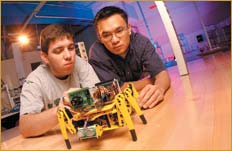

 |
| Second Phase of GE Learning
Projects Funded In 2000 the General Electric Fund awarded a $300,000 grant to the University in support of the development of innovative, interdisciplinary curricula and teaching modules for undergraduates. Among the criteria for each module was that it help bridge traditional disciplinary boundaries and provide students with experiences that highlight the interfaces between disciplines, enhancing their education and better preparing them for careers in engineering. The initial set of modules, which included projects focusing on microcontroller interfacing, microelectromechanical systems, and the degradation of organic contaminants in groundwater flows, were created for the 2001-02 academic year. Three more projects have been developed and are being implemented for the current academic year. The new modules focus on building complete autonomous robots, remote sensing and data acquisition using a microprocessor-based system, and satellite communications. Using the “building complete autonomous robots” module, students from the departments of aerospace and mechanical engineering and computer science and engineering will be able to experiment with a robot at various stages of its development as a complete system while also exploring the variety of tasks which can be assigned to the mechanism itself. As they create the six-legged robot, the course requirement, they will be able to rely on the functional implementations of the other disciplines -- such as vision control, artificial intelligence, and navigation -- which are being prepared by faculty and will be stored in the Engineering Learning Center. Students will also learn how to use microcontrollers for data acquisition in the “remote sensing and data acquisition using a microprocessor-based system” module. Throughout the course of the module, they will explore the data acquisition process and learn how to analyze data and draw meaningful conclusions. Faculty from aerospace and mechanical engineering and electrical engineering developed this module. The “satellite communications” module creates a bidirectional communication link -- satellite-earth, providing hands-on activities for undergraduates in the electrical engineering and aerospace and mechanical engineering departments. Students using this module will learn how to map antenna patterns and take field measurements, but they will also gain practical experience in developing communication link budgets and estimating orbital elements from acquired signal parameters. |